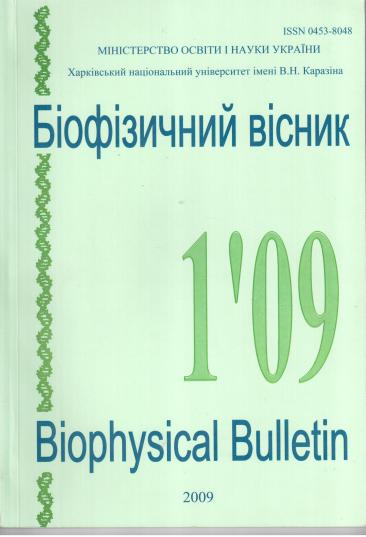Спектральні характеристики червоних флуоресцентних білків, що змінюють спектр флуоресценції в часі
Анотація
Вивчено спектральні характеристики трьох мономерних флуоресцентних білків - флуоресцентних таймерів (ФТ), створених з вихідного білка mCherry. Основною особливістю ФТ є здатність змінювати свою флуоресценцію з блакитної на червону в часі. Отримані варіанти характеризуються великою (Б), середнім (С) і малим (М), часом дозрівання хромофора від блакитного до червоного. Час переходу від блакитної флуоресценції до червоної зворотньопропорційно температурі. При температурі 37 0 C, максимуми блакитної флуоресценції спостерігаються через 0,25, 1,2 і 9,8 години для очищених БФТ, СФТ і МФТ, відповідно. Полумаксімуми червоної флуоресценції у цих білків спостерігаються через 3,9; 7,1 і 28 годин. У всіх трьох варіантів ФТ піки порушення і флуоресценції для блакитних форм рівні 403 нм і 583 нм, а для червоних форм - 466 нм і 606 нм відповідно. Флуоресценція всіх вивчених форм ФТ має високу pHстабільность в області рН від 4,5 до 7,5 багатозначно pKa, відповідно, близько 3,0 для блакитних і 4,1-4,7 для червоних форм. Молярні коефіцієнти екстинкції і квантові виходи блакитних форм ФТ знаходяться в межах 33400-49700 M-1cм-1 і 0,30-0,41, відповідно Коефіцієнти екстинкції червоних форм ФТ вище, ніж для блакитних, і варіюють від 75300 M-1cм-1 у БФТ до 84200 M-1cм-1 у МФТ. Квантові виходи червоних форм ФТ знаходяться в межах 0,05-0,09. Флуоресцентні властивості досліджених варіантів ФТ дозволяють вивчати процеси з істотно відрізняючимися тимчасовими характеристиками. Досліджені ФТ можна також використовувати при створенні пар з зеленими флуоресцентними білками для флуоресцентного індуктивного перенесення енергії від блакитної форми на зелену, або від зеленої на червону, що розширює можливості кольорової флуоресцентної внутрішньоклітинної детекції.
Завантаження
Посилання
Subach F.V., Subach O.M., Gundorov I.S., Morozova K.S., Piatkevich K.D., Cuervo A.M., Verkhusha V.V.
Monomeric fluorescent timers that change the color from blue to red. Nat. Chem. Biol. 5 (2), 118-126 (2009)
Niwa, H. et al. Chemical nature of the light emitter of the Aequorea green fluorescent protein. Proc. Natl. Acad.
Sci. U. S. A. 93, 13617-13622, (1996).
Chudakov, D.M. et al. Photoswitchable cyan fluorescent protein for protein tracking. Nat. Biotechnol. 22, 1435-
, (2004).
Patterson, G.H., Knobel, S.M., Sharif, W.D., Kain, S.R. & Piston, D.W. Use of the green fluorescent protein and
its mutants in quantitative fluorescence microscopy. Biophys. J. 73, 2782-2790, (1997).
Shaner, N.C., Steinbach, P.A. & Tsien, R.Y. A guide to choosing fluorescent proteins. Nat. Methods. 2, 905-909,
(2005)
Автори, які публікуються у цьому журналі, погоджуються з наступними умовами:
- Автори залишають за собою право на авторство своєї роботи та передають журналу право першої публікації цієї роботи на умовах ліцензії Creative Commons Attribution License, котра дозволяє іншим особам вільно розповсюджувати опубліковану роботу з обов'язковим посиланням на авторів оригінальної роботи та першу публікацію роботи у цьому журналі.
- Автори мають право укладати самостійні додаткові угоди щодо неексклюзивного розповсюдження роботи у тому вигляді, в якому вона була опублікована цим журналом (наприклад, розміщувати роботу в електронному сховищі установи або публікувати у складі монографії), за умови збереження посилання на першу публікацію роботи у цьому журналі.
- Політика журналу дозволяє і заохочує розміщення авторами в мережі Інтернет (наприклад, у сховищах установ або на особистих веб-сайтах) рукопису роботи, як до подання цього рукопису до редакції, так і під час його редакційного опрацювання, оскільки це сприяє виникненню продуктивної наукової дискусії та позитивно позначається на оперативності та динаміці цитування опублікованої роботи (див. The Effect of Open Access).





